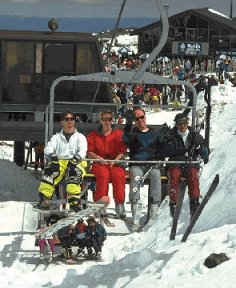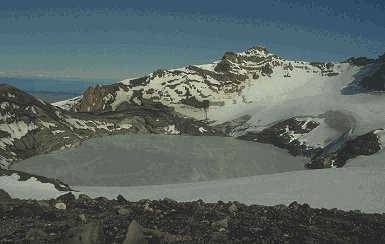![]()
Coasts
Rivers/Lakes
Lowlands/Plains
Geysers/Mud
Glaciers
Mt. Ruapehu
Mt. Cook
White Island
A Maori Legend
![]()
Abbotsford
Aramoana
Ballantynes
Brynderwyns
Cave Creek
Hawkes Bay
H.M.S. Orpheus
Influenza
Mt. Erebus
Mt. Tarawera
Rainbow Warrior
Seacliff Hospital
Tangiwai
Wahine
![]()
Annie Aves
Ata-hoe
Daisy Basham
Jean Batten
Minnie Dean
Mabel Howard
Margaret Mahy
Kath Mansfield
Kate Sheppard
Kiri Te Kanawa
Catherine Tizard
Murray Ball
Charles Goldie
Edmund Hillary
Richard Pearse
Lord Rutherford
Charles Upham
![]()
NZ FAQ--Funny
NZ Links
Credits
For 50 years Mt. Ruapehu slumbered. On almost the 50th anniversary of its last major eruption the mountain sprang back into life as if to celebrate..... Ruapehu is the highest mountain in the North Island of New Zealand at 2797 m/9175 ft. The volcanic range which includes Ruapehu also contains two other active volcanic peaks: Mt. Ngauruhoe (2291 m/7515 ft) and Mt. Tongariro (1968 m/6458 ft). Despite being the lowest of the three mountains Tongariro gave its name to the surrounding National Park. In the West extremity of the island also sits Mt. Taranaki, formerly known as Mt. Egmont (2518 m/8260 ft). This is a solitary, extinct volcanic cone known particularly for its near perfect conical shape which is broken by only one outcrop, a secondary cone called Fanthams Peak. The Maori name, Taranaki, means 'barren mountain'.
A little
known fact is that the biggest single source of fatalities from
natural disasters in New Zealand has been due to volcanic activity.
Ruapehu has erupted many times over the last one thousand years
and in recent times was very active in 1945, (when Wellington, New
Zealand's capital city, was showered with ash), 1969, 1971, 1974
and 1975. As a result of this activity an early warning system was
installed.
Ruapehu stands right in the centre of one of the most active geological areas in the world and it is considered one of the world's most active volcanoes. The most recent eruption was in September of 1995. This continued for a month with black mud, lahars and lava flows being just part of the performance. Plumes of steam and ash erupted up to 12 kilometres into the sky endangering aircraft. Ash falls closed roads and skiing facilities. At one stage up to 15,000 tonnes per day of sulphur dioxide gas was emitted from a vent in the floor of the crater. Neighbouring Mt. Ngauruhoe also erupts spectacularly every few years showering her slopes with ash and lava. At other times this mountain frequently belches steam and gas. Mt Ruapehu was also the source of New Zealand's first accident involving a commercial airliner and resulting in a substantial loss of life. This was on the 23rd October 1948, when the Lockheed Electra airliner 'Kaka' operated by National Airways crashed on the mountain. Thirteen passengers and crew died and it was seven days after the crash before the wreckage was finally located largely because bad weather slowed the search. Despite all its volcanic activity the mountain is extremely popular for the skiing it offers. Overseas instructors provide an international flavour and there are fields to suit every category of skier from gentle nursery slopes to the thrilling National Downhill. The park is also popular with trampers and experienced climbers enjoy the challenge of attempting the conquest of all three peaks in just a single day. Thirty years ago visitors could also experience the joys of swimming in Crater Lake on what is a perpetually snow-capped mountain. These days the lake has become too unpredictable and acidic. Temperatures fluctuate between 10 and 60 degrees centigrade depending upon how active the magma beneath the lake is.
|



